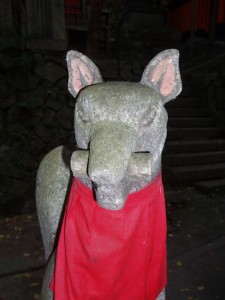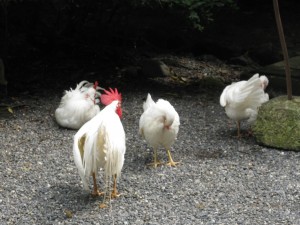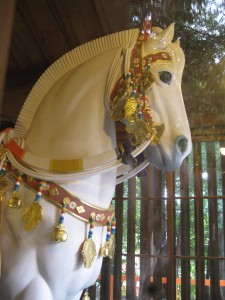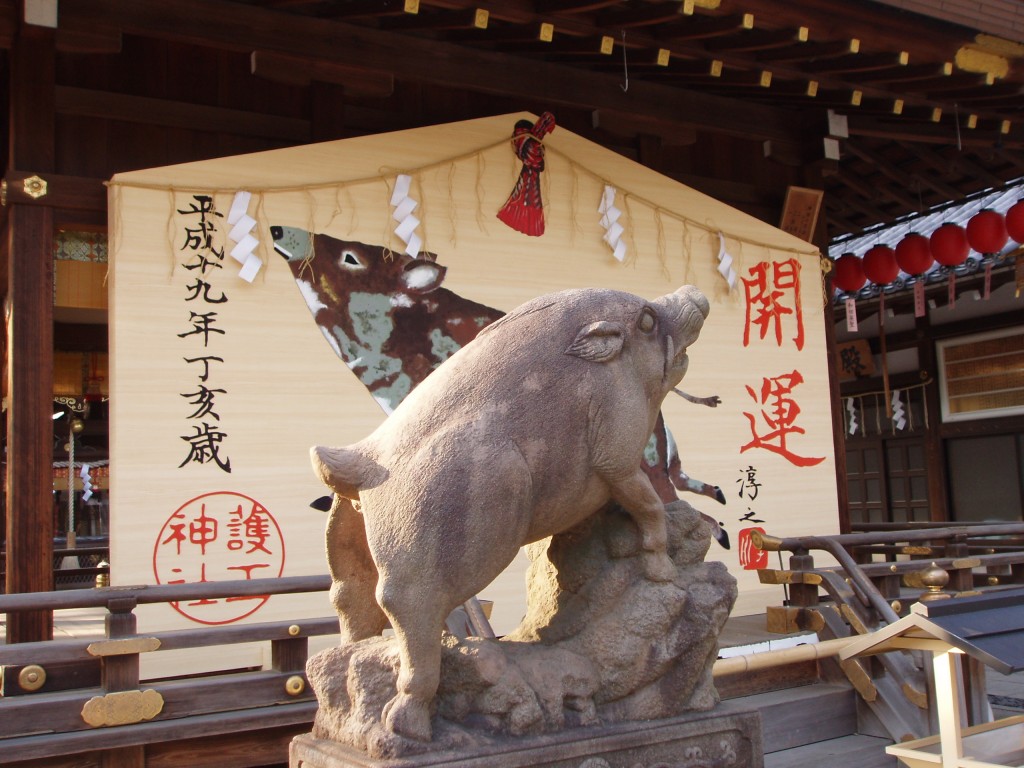
Inari's fox
In Shinto animals are seen as spirit messengers, and I take this to be derived from shamanism where they aid the shaman in taking flight to the spirit world. Particular animals are associated with certain kami. The fox with Inari, pigeon/dove with Hachiman, cockerel with Amaterasu, the rat with Okuninushi, deer with the Kasuga deity, the dragon with Ryujin, the ox with Tenjin and the white snake with Benten. In addition, komainu guard the shrines and white horses mediate between the human and spirit world (connections here with horseriding cultures in Puyo and Mongolia).
In tribal communities the shamanic power animal was adapted as a totemic ancestor, and it’s my feeling that ancient affinities in Japan originated in similar manner. The Kamo for instance were the crow tribe and claim the three-legged crow as their clan ancestor (see separate posting on yatagarasu). The Fujiwara clan whose tutelary shrine was Kasuga at Nara were the deer people; the Hata who founded Fusimi Inari were the fox clan; and the Ainu seem to have been the bear people.

Ise cockerels
If you visit Ise Jingu, you’ll find cockerels walking around the grounds as a familiar of Amaterasu, the sun goddess. According to folklore, they act as her assistant and wake her every morning. In the mythology they play a part in the Cave myth where they feature in the enticing of the sun goddess to come out. Some experts suggest they may be the bird referred to in the torii (bird’s roost), since villages in ancient times kept their chickens on crossbeams at the boundary of the settlement. In this respect I found it of interest when I was in Korea that in villages it was customary to keep a pair of sotdae at the village entrance (poles with a sculptured bird on top, which communicated with the gods).
Just as the cockerels lead one back to continental origins, I think too the power animals of early Shinto can be traced back to the continent. There were dog tribes, deer tribes, fox tribes in ancient China and Korea. Immigrant groups as they moved into Japan no doubt brought their traditions in with them. Over time the shamanic power animal morphed into an emissary of the Shinto kami.

White horse at Fushimi Inari
As an animal rightist, I would have hoped that the fondness for animal familiars would translate into compassion in every day life. Sadly this is far from the case, and I’ve witnessed animals cooped up on shrine properties in conditions that in the West would be condemned as cruel. There is too a Shinto festival where horses are beaten so severely to make them climb a steep hill that it has aroused international condemnation. How is one to explain this? I think Joseph Campbell provides an answer when he highlights the tendency of paleolithic people to worship the spirit of the animal they kill. The spirit is sacred; the physical creature is not.
i can’t help wondering if there is a connection here between the cult of cute animals so evident in Japan and the indifference to suffering. Toy dogs and koala bears are fawned over, whereas whales are mercilessly harpooned and dolphins ruthlessly slaughtered. Japanese zoos are notorious for their cruel conditions, and it’s common to see dogs tied up on concrete all day with barely room to move. One might have hoped that Shinto would be in the vanguard of those speaking out against such practices. More power to the animals!

Wild boar at Goo Jinja in Kyoto

Isonokami Jinja near Tenri in Nara, another very ancient shrine, also has cockerels as the god’s messengers. It has plenty of continental connections, too. Notably, the marvellous Dark Age Korean gift of the Sword of the Big Dipper with branching blades.
So, I have a quick question for you. You mentioned the wolf being associated with the kami called Sanjo. Can you tell me where you heard of this name? I have never heard of Sanjo and would like to know more about this kami. Thank you!
Thanks, Jonathan. That’s a good point… According to my notes, it was from a talk by an Indian professor at Nichibunken, here in Kyoto, but I can’t find any corroboration of the name and some of the other information the professor gave struck me as dubious. The internet suggests that Mitsumine Shrine in Chichibu is closely related to a wolf kami but I can’t see any suggestion of it being called Sanjo… There’s a useful webpage about it here: http://darumapilgrim.blogspot.com/2005/09/mitsumine-shrine.html
Until I find out for sure, I’m going to remove the Sanjo reference.